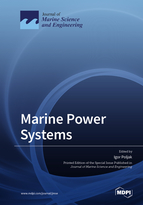Marine Power Systems
A special issue of Journal of Marine Science and Engineering (ISSN 2077-1312). This special issue belongs to the section "Ocean Engineering".
Deadline for manuscript submissions: closed (1 October 2021) | Viewed by 44959
Special Issue Editor
Interests: energy analysis; turbo-generators and steam turbines; energy conversion; marine propulsion plant; marine refrigerant systems; reliability and maintenance of marine power plants; optimization of power plant systems
Special Issues, Collections and Topics in MDPI journals
Special Issue Information
Dear Colleagues,
This Special Issue focuses on marine power systems. The specific subject dealt with is the analysis of energy conversion and its possible optimization; this includes steam power plants, motor power plants, gas turbine power plants, DFDE power plants, COGAS, CODLAG, as well as other combinations, including fuel cell propulsion sources and their applications in marine propulsion and power generation systems. This Special Issue welcomes studies from the fields of reliability and maintenance applications of marine power generation systems, as these fields are central to the problems associated with marine power generation. Furthermore, this Special Issue welcomes studies related to marine auxiliary systems, which are of vital importance for each marine power generation system.
Researchers from both academia and the industry are invited to submit original articles that advance the state of the art of Marine Power Systems applications or review the progress and future directions of research in the field of marine engineering.
Dr. Igor Poljak
Guest Editor
Manuscript Submission Information
Manuscripts should be submitted online at www.mdpi.com by registering and logging in to this website. Once you are registered, click here to go to the submission form. Manuscripts can be submitted until the deadline. All submissions that pass pre-check are peer-reviewed. Accepted papers will be published continuously in the journal (as soon as accepted) and will be listed together on the special issue website. Research articles, review articles as well as short communications are invited. For planned papers, a title and short abstract (about 100 words) can be sent to the Editorial Office for announcement on this website.
Submitted manuscripts should not have been published previously, nor be under consideration for publication elsewhere (except conference proceedings papers). All manuscripts are thoroughly refereed through a single-blind peer-review process. A guide for authors and other relevant information for submission of manuscripts is available on the Instructions for Authors page. Journal of Marine Science and Engineering is an international peer-reviewed open access monthly journal published by MDPI.
Please visit the Instructions for Authors page before submitting a manuscript. The Article Processing Charge (APC) for publication in this open access journal is 2600 CHF (Swiss Francs). Submitted papers should be well formatted and use good English. Authors may use MDPI's English editing service prior to publication or during author revisions.
Keywords
- energy analysis
- turbo-generators and steam turbines
- energy conversion
- marine propulsion plant
- marine refrigerant systems
- reliability and maintenance of marine power plants
- optimization of power plant systems






